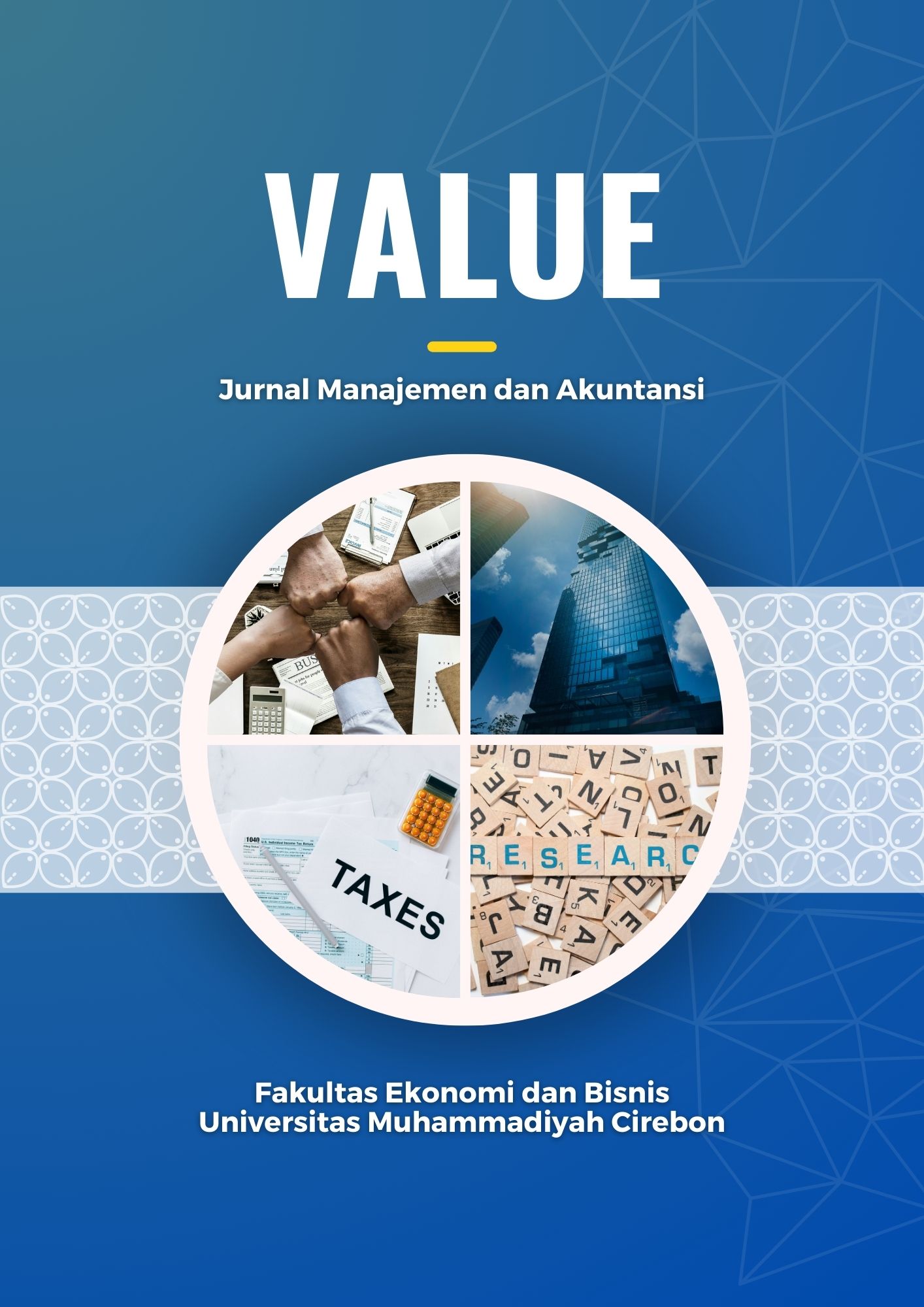Cashless Behavior And E-Wallets In Gen Z’s Financial Management
DOI:
https://doi.org/10.32534/jv.v20i3.7453Keywords:
Digitalization, Cashless Payment Behavior, Digital Wallet Usage, Personal Financial Management, Generation ZAbstract
This study investigates the influence of cashless payments and digital wallets on the financial management of Generation Z in Makassar, focusing on key issues such as impulsive spending, low financial literacy, and data security. Although this generation is known to be technologically literate, many still lack the skills to manage their finances wisely. The study employed a quantitative approach with an explanatory design and involved 120 respondents aged 17 to 26 who actively use e-wallets in their daily financial activities. Data were analyzed using multiple linear regression with SPSS version 26. Statistical results showed that cashless payment behavior had a positive and significant effect on personal financial management (β = 0.421, p < 0.01), as did the use of digital wallets (β = 0.388, p < 0.01), contributing to greater efficiency and accuracy in financial management. The R² value of 0.56 indicates that both independent variables collectively explain 56% of the variance in personal financial management. Features such as automatic transaction recording, spending notifications, and payment reminders play a role in enhancing financial literacy and discipline. This study concludes that the careful adoption of digital financial technology can serve as a strategic tool for fostering healthy, structured, and sustainable financial behavior among Generation Z.
References
Ajzen, I. (1991). The Theory of Planned Behavior.
Ajzen, I. (2020). The theory of planned behavior: Frequently asked questions. Human Behavior and Emerging Technologies, 2(4), 314–324. https://doi.org/10.1002/hbe2.195
Anggraeni, S., & Ganarsih, I. (2025). The Influence of Fintech Adoption and Cashless Payment Behavior on Financial Management Practices in Generation Z. Lentera Manajemen Keuangan. https://lenteranusa.id/
Anindito, R., Kusuma Edy Prodi Ekonomi Pembangunan, J., & Ekonomi dan Bisnis Universitas Jambi, F. (2024). Pengaruh penggunaan dompet digital (ShopeePay) terhadap perilaku konsumsi mahasiswa (Studi pada mahasiswa Universitas Jambi Fakultas Ekonomi dan Bisnis). In Jurnal Paradigma Ekonomika (Vol. 19, Issue 4). https://doi.org/10.22437/jpe.v19i4.40522
Anwar, A. I., Nalurita, S. S., & Hamrullah, H. (2022). Pengaruh Penggunaan E-Wallet terhadap Konsumsi. Ekonomika Dan Dinamika Sosial.
Ardini, L., Fahlevi, M., Dandi, M., Dahlan, O. P., & Dahlan, S. P. (2024). Digital Financial Literacy and Its Impact on Financial Skills and Financial Goals in Indonesia’S Digital Payment Ecosystem. Ikonomicheski Izsledvania, 33(7), 181–200. Retrieved from https://econpapers.repec.org/RePEc:bas:econst:y:2024:i:7:p:181-199
Baumeister, R. F. , & V. K. D. (2004). Handbook of self-regulation.
Chelvarayan, A., Yeo, S. F., Hui Yi, H., & Hashim, H. (2022). E-Wallet: A Study on Cashless Transactions Among University Students. F1000Research, 11, 687. https://doi.org/10.12688/f1000research.73545.1
Chhillar, N., & Arora, S. (2022). Personal financial management behavior using digital platforms and its domains. Journal of Financial Management, Markets and Institutions, 10(2). https://doi.org/10.1142/S2282717X22500098
Davis, F. D. (1989). Perceived usefulness, perceived ease of use, and user acceptance of information technology. MIS Quarterly: Management Information Systems, 13(3), 319–339. https://doi.org/10.2307/249008
Eka Saputra, S., Setiadi, I., & Anshori, A. (2024). Literacy analysis of digital financial inclusion of zakat, Infaq, Alms and Religious Social Affairs (Ziska) at Lazismu Sangkapura Branch, Gresik Regency. In International Journal on Social Science, Economics and Art (Vol. 14, Issue 1). Retrieved from https://ijosea.isha.or.id/index.php/ijosea/article/view/443
Elsalonika, A., & Ida, I. (2025). PERILAKU KEUANGAN GENERASI Z: PERAN PENERAPAN FINANCIAL TECHNOLOGY, LITERASI KEUANGAN, DAN EFIKASI DIRI. https://doi.org/https://doi.org/10.24912/jmbk.v9i2.32838
Ermalina Rumbik, F., Kurniawan, R., & Ginting, R. (2024). Menguak Perilaku Konsumtif Generasi Z dalam Penggunaan Digital Payment dan Literasi Keuangan Berdasarkan Mental Accounting : Sebuah Studi Fenomenologi. Jurnal Akuntansi AKUNESA, 12(2). https://doi.org/10.26740/akunesa
Farrell, L., Fry, T. R. L., & Risse, L. (2016). The significance of financial self-efficacy in explaining women’s personal finance behaviour. Journal of Economic Psychology, 54, 85–99. https://doi.org/10.1016/j.joep.2015.07.001
Fitri Wahyuni, S., Puji Lestari, S., & Sri Indah Lestari, S. (2024). Keterkaitan antara Literasi Keuangan dan Pendapatan Pada Kesejahteraan Keuangan : Mediasi Prilaku Keuangan Generasi Sandwich. In Jurnal Ekonomi dan Bisnis (Vol. 3, Issue 1). https://doi.org/10.59086/jeb.v3i1.551
Gita Safitri, A., Adeati, D., Azzahro, A., & Habibah Al Ihsani, R. (2022). Pengaruh E-Wallet terhadap Perilaku Konsumtif Mahasiswa Fakultas Ekonomi Universitas Negeri Semarang. In Jurnal Potensial (Vol. 1, Issue 1). http://jurnalilmiah.org/journal/index.php/potensial
Hair, J. F., Hult, G. T. M., Ringle, C. M., & Sarstedt, M. (2022). A Primer on Partial Least Squares Structural Equation Modeling (PLS-SEM). SAGE Publications.
Hair, J. F., Hult, G. T. M., Ringle, C. M., Sarstedt, M., Danks, N. P., & Ray, S. (2021). Partial Least Squares Structural Equation Modeling (PLS-SEM) Using R. http://www.
Ismamudi, Hartati, N., & Sakum. (2023). Peran Bank dan Lembaga Keuangan dalam Pengembangan Ekonomi: Tinjauan Literatur. Akuntasi Neraca.
Johan, S. (2020). Users’ acceptance of financial technology in an emerging market (An empirical study in Indonesia). Jurnal Ekonomi Dan Bisnis, 23(1), 173–188. https://doi.org/10.24914/jeb.v23i1.2813
Kanungo, R. P., & Gupta, S. (2021). Financial inclusion through digitalisation of services for well-being. Technological Forecasting and Social Change, 167(July 2020), 120721. https://doi.org/10.1016/j.techfore.2021.120721
Klimontowicz, M., & Harasim, J. (2022). Payment Features and Incentives as Drivers for Non-Cash Payments Usage – the Evidence from Poland. Annales Universitatis Mariae Curie-Sk?odowska, Sectio H – Oeconomia, 56(3), 37–59. https://doi.org/10.17951/h.2022.56.3.37-59
Madini, R., Irfani Hendri, M., Malini, H., Yakin, I., Tanjungpura, U., Jl Profesor Dokter H Hadari Nawawi, J. H., Laut, B., Pontianak Tenggara, K., Pontianak, K., & Barat, K. (2023). The effect of financial literacy and love of money on the financial management behavior of generation z. In IJAFIBS (Vol. 11, Issue 3). www.ijafibs.pelnus.ac.id
Medina, A., & Gunawan, A. (2024). The Impact Of Hedonism Lifestyle, Emotional Intelligence And Spiritual Intelligence On Personal Financial Management Of Generation Z In Medan City. In IJRS: International Journal Reglement & Society (Vol. 5). https://doi.org/10.55357/ijrs.v5i3.691
Mirsa Jamilah, A. (2024). Strategic Benefits Of Implementing Effective Financial Man-agement For Micro, Small And Medium Enterprises (MSME) In Jepara District. In JPPA) Journal of Public Policy Analysis. 2024 (Vol. 1). Retrieved from https://businessandfinanceanalyst.com/index.php/JPPA/article/view/121
Moon, I. T., Shamsuzzaman, M., Mridha, M. M. R., & Rahaman, A. S. Md. M. (2022). Towards the Advancement of Cashless Transaction: A Security Analysis of Electronic Payment Systems. Journal of Computer and Communications, 10(07), 103–129. https://doi.org/10.4236/jcc.2022.107007
Mubyl, M., Abidin, A., & Ramadhani, N. M. (2021). Faktor-Faktor Yang Mempengaruhi Minat Penggunaan E-Wallet (Studi Kasus Pada Mahasiswa Kota Makassar). Nobel Management Review, 2(4). https://doi.org/10.37476/nmar.v2i4.2963
Nikita Sari, A., Umi Mintarti, S., & Hadi Utomo, S. (2020). Penggunaan E-wallet dalam Membentuk Perilaku Konsumsi Mahasiswa. http://journal.um.ac.id/index.php/jptpp/
OECD. (2018). Digitalisation and Financial Literacy. www.oecd.org/going-digital.
OECD. (2020). Advancing the Digital Financial Inclusion of Youth.
OJK. (2025). OJK and BPS Announce the Results of the 2025 National Survey on Financial Literacy and Inclusion (SNLIK). https://institute.ojk.go.id/iru/news/detailnews/13688/ojk-and-bps-announce-the-results-of-the-2025-national-survey-on-financial-literacy-and-inclusion-snlik
Palinggi, Y., Tantiana, E., & Erwinsyah, E. (2023). Analisis Perbandingan Persepsi Konsumen Pengguna E-Wallet (Studi Kasus Mahasiswa Fakultas Ekonomi Dan Bisnis Universitas Kutai Kartanegara). Jurnal Ekonomi & Manajemen Indonesia, 23(2). https://doi.org/10.53640/jemi.v23i2.1409
Payne, J. W. , B. J. R. & J. E. J. (2011). The Adaptive Decision Maker. Psychology, 2.
Philippas, N. D., & Avdoulas, C. (2020). Financial literacy and financial well-being among generation-Z university students: Evidence from Greece. European Journal of Finance, 26(4–5), 360–381. https://doi.org/10.1080/1351847X.2019.1701512
Suade, Y. K. M., Hartono, P. G., Erwin, E., Monalisa, M., & Sharon, S. S. (2024). Assessing the Role of Financial Self-Efficacy to Enhance Financial Well-Being among University Students in Western Java Land, Indonesia. Jurnal Proaksi, 11(3), 582–596. https://doi.org/10.32534/jpk.v11i3.6245
Suryawirawan, A. (2025). Transformasi Qris sebagai Instrumen Pembayaran Digital dalam Perspektif Ekonomi Syariah. 4, 81–94. https://doi.org/10.55606/jempper.v4i1.4892
Tay, L. Y., Tai, H. T., & Tan, G. S. (2022). Digital financial inclusion: A gateway to sustainable development. Heliyon, 8(6), e09766. https://doi.org/10.1016/j.heliyon.2022.e09766
Thi, N., Phuong, H., Dieu, N., Tran, T., Giang, L., Thi, B., Han, N., Hoang, T., Nguyen, H., & Long, T. (2022). DETERMINANTS OF INTENTION TO USE FINTECH PAYMENT SERVICES: EVIDENCE FROM VIETNAM’ GENERATION Z. International Journal of Business, Economics and Law, 26(1). Retrieved from https://ijbel.com/wp-content/uploads/2022/06/IJBEL26.ISU1_301.pdf
Vasile, V., Panait, M., & Apostu, S. A. (2021). Financial inclusion paradigm shift in the postpandemic period. Digital-divide and gender gap. International Journal of Environmental Research and Public Health, 18(20). https://doi.org/10.3390/ijerph182010938
Warjiyo, P. (2025). Bank Indonesia: Volume Transaksi QRIS Tumbuh 175,2 Persen. ANTARA News. https://www.antaranews.com/berita/4586130/bank-indonesia-volume-transaksi-qris-tumbuh-1752-persen#google_vignette
Wikipedia contributors. (2025a). QR code payment. Wikipedia, The Free Encyclopedia. https://en.wikipedia.org/wiki/QR_code_payment
Wikipedia contributors. (2025b). QRIS. Wikipedia, The Free Encyclopedia. https://id.wikipedia.org/wiki/Kode_Respons_Cepat_Standar_Indonesia
Witono, P. H. (2023). Pengaruh Pendidikan Keuangan di Keluarga, Uang Saku dan Gaya Hidup Terhadap Pembentukan Karakter Mahasiswa. Indonesian Character Journal, 1(1), 1–8. https://doi.org/10.21512/icj.v1i1.10306
Yang, M., Al Mamun, A., Mohiuddin, M., Nawi, N. C., & Zainol, N. R. (2021a). Cashless transactions: A study on intention and adoption of e-wallets. Sustainability (Switzerland), 13(2), 1–18. https://doi.org/10.3390/su13020831
Yang, M., Al Mamun, A., Mohiuddin, M., Nawi, N. C., & Zainol, N. R. (2021b). Cashless transactions: A study on intention and adoption of e-wallets. Sustainability (Switzerland), 13(2), 1–18. https://doi.org/10.3390/su13020831


















